Dolphins and Familial Bonds: An In-Depth Exploration
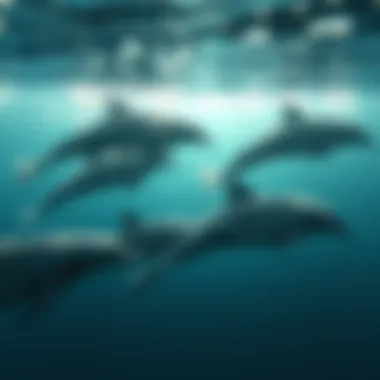

Intro
Throughout the azure depths of our oceans, dolphins glide gracefully, their sleek bodies intertwining with the currents. These fascinating creatures, often praised for their intelligence and social nature, exemplify interaction that extends far beyond mere survival. Social structures among dolphins showcase familial bonds that can rival those found in human families. This article sets out to explore the intricacies of these familial connections and their implications for behavior, communication, and conservation.
Dolphins, often seen in pods, display a remarkable cohesion that suggests a strong sense of connectivity. Different species of dolphins exhibit varying degrees of social complexity, but all reveal an innate tendency to form tight-knit family structures. Their familial ties are not just limited to immediate offspring; they often include extended family members, displaying a loyalty that echoes across generations.
Diving further into this exploration, we will look at how these bonds impact their behavior, such as foraging techniques, play, and even communication patterns within pods. Understanding these dynamics not only enriches our knowledge of dolphin life but also highlights the importance of protecting their habitats, as family unity often corresponds with successful breeding and survival rates.
Key Points to Discuss
- Family Structures: Exploring the composition of dolphin pods and their significance in social settings.
- Behavioral Implications: How family connections influence hunting strategies, migration patterns, and communal care.
- Communication: The role of vocalizations and body language in strengthening social ties.
- Conservation Efforts: Addressing how understanding familial bonds aids conservation strategies, aiming for the preservation of these intelligent beings.
As we meander through these topics, we'll reveal the vital roles family play in dolphin societies, showcasing the need for safeguarding their environments to ensure these dynamic bonds continue for generations to come.
Prologue to Dolphin Social Structures
Understanding dolphin social structures is a voyage into a captivating world where familial bonds shape every facet of life for these marine creatures. Dolphins are not mere soloists gliding through the water; they are players in a complex orchestra of relationships that influences their survival and wellbeing. Their social hierarchies, often intricate and nuanced, contribute significantly to their behaviors, communication styles, and maternal care practices.
Dolphins are known to form tight-knit family groups, often consisting of mothers and their offspring, sometimes extending to grandmothers and aunts. This familial network provides a stable environment that nurtures the young, ensuring the transfer of learned behaviors and survival tactics. In essence, the family unit is the backbone of dolphin society, molding not just individual identities, but also the collective resilience of the species against challenges like predation and habitat degradation.
Understanding Dolphin Families
Dolphin families are quite unique. They're generally matrifocal, meaning the center of activity and support revolves around female dolphins. Mothers play a pivotal role in raising their calves. They impart skills necessary for hunting, sometimes taking their young on forays to teach them about their environment. This element of learning is vital; calves need to soak up knowledge and skills to thrive as adults.
The family structure can vary significantly among different dolphin species. For instance, bottlenose dolphins often form small, stable groups, sometimes referred to as pods. These pods may be flexible, with individuals coming and going over time, yet the essence of familial ties remains intact. In contrast, orca families, which belong to the dolphin family, display a different dynamic. They are known for their long-term bonds - male orcas often stay with their mothers for life. This support structure provides strength and stability, crucial for foraging and protection against threats.
Importance of Social Bonds
The social bonds between dolphins aren’t just about companionship; they hold key benefits that impact their day-to-day activities and long-term survival. Strong social ties can lead to improved foraging success, as dolphins often cooperate to herd fish, demonstrating a remarkable ability to work together. This collaboration is not only efficient but also a fascinating display of intelligence and social coordination.
The bonds formed within dolphin families can also serve as a source of emotional support during challenging times. Like humans, dolphins express emotions, and family members can comfort one another during periods of distress or danger. Researchers have documented instances of dolphins showing signs of grief when a family member dies, revealing a profound emotional connection that challenges our understanding of animal emotions.
"Dolphins are renowned for their complex emotions and social interactions, painting a picture of intelligence that often makes us reflect on our own connections."
In the context of conservation, recognizing the importance of social bonds enables better protection strategies. When families are disrupted by human activities—such as fishing, boating, and habitat destruction—the implications can ripple through the dolphin population, affecting everything from reproductive success to the resilience of future generations.
Diving into the realm of dolphin families enriches our appreciation of these intelligent beings. The more we learn about their structures and bonds, the clearer it becomes that they are not just creatures of the sea, but intricate social beings navigating their world with intelligence and emotional depth. Understanding these dynamics is vital for fostering effective conservation efforts aimed at preserving not only their existence but the integrity of marine ecosystems as a whole.
Types of Dolphin Family Units
Understanding the different types of dolphin family units is crucial for grasping how these intricate social structures function. Dolphins are known for their vibrant social dynamics, which can best be observed through their familial ties. Family units not only influence individual dolphins’ behavior and survival but also play a vital role in maintaining the health of the species as a whole. By studying these units, researchers gain insights into communication patterns, social organization, and conservation strategies necessary for their protection. In essence, the variety in dolphin family structures reflects the adaptability and complexity of their social systems.
Nuclear Families and Their Roles
Dolphin nuclear families usually consist of a mother and her offspring, and sometimes a mate. This familial unit has profound significance in the early development of calves. Young dolphins learn critical survival skills, social behaviors, and communication techniques within this intimate setup. Mothers often take the lead role, teaching their young how to hunt, navigate their environment, and interact with other dolphins.
What is interesting is how these mothers do not merely care for their young physically, but also engage in nurturing behaviors that promote emotional bonds. For instance, mother dolphins will often engage in playful activities with their calves, which reinforces social learning. This exuberance not only helps calves learn important skills but also strengthens the emotional foundations of their relationships.
Additionally, within these nuclear families, the presence of siblings can be observed. Sibling dolphins often assist in caring for the young, forging additional bonds that can last well into adulthood. Such collaborative efforts can be seen as a reflection of the evolving dynamics within dolphin societies, whereby family members contribute to the overall well-being of their family unit.
Extended Family Groups
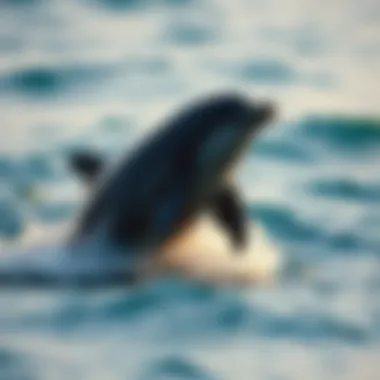
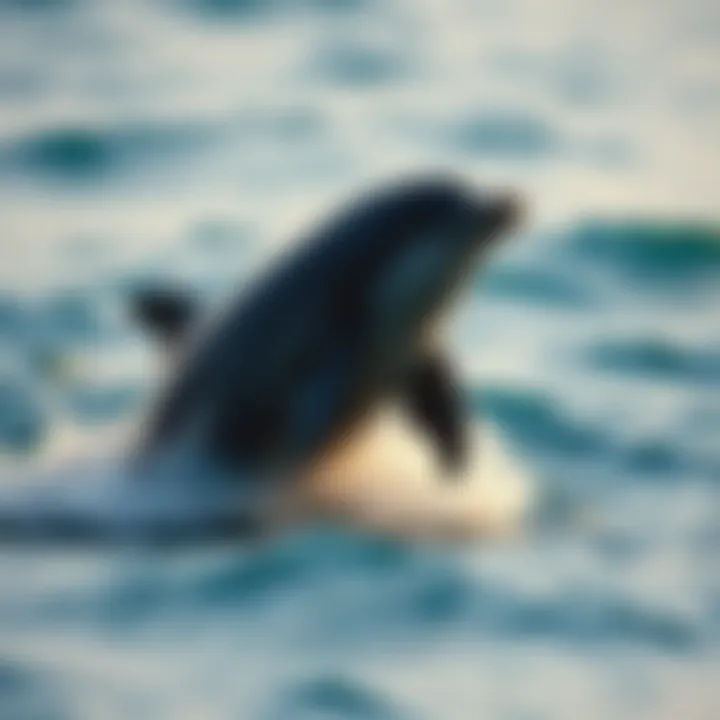
In contrast to the nuclear family, extended family groups can vary significantly in composition and size. These groups may include multiple generations, where grandmothers and aunts play important roles alongside mothers. Extended families often provide a robust support system, enabling members to share responsibilities like caring for calves and finding food.
The bond within these larger units can also amplify the social learning process. Young dolphins in extended families have more role models to observe and interact with, which can enhance their ability to adapt to changing environments and challenges. Moreover, in these extended groups, dolphins can establish intricate social networks that may assist in critical survival functions, like coordinated hunting techniques.
The significance of extended family groups is especially apparent in species like the orca, where family units, or pods, are tightly knit. Each pod has its own unique vocalizations and hunting methods that are passed down through generations, linking familial ties with cultural identity.
In summary, dolphin family structures, whether nuclear or extended, not only establish critical social bonds but also facilitate knowledge transfer essential for survival.
Communication Within Dolphin Families
Understanding the ways dolphins communicate within their families is fundamental to grasping the dynamics of their social structures. Dolphins are not just social animals; they are sophisticated communicators. Their ability to share information is crucial for maintaining family ties, coordinating group activities, and ensuring the survival of their pods. These intricate systems of communication enhance social bonds and help in navigating the complexities of their environment. The depth of communication between dolphins goes beyond mere sounds; it encapsulates emotional nuances and behavioral cues that paint a vivid picture of their social lives.
Vocalizations and Their Meaning
Dolphins are famous for their diverse vocalizations. They can produce a range of sounds, from clicks and whistles to pulsed calls. Each vocalization serves a distinct purpose, acting almost like a language unique to dolphin families. For example:
- Clicks are primarily used for echolocation, helping dolphins navigate underwater and locate prey. This is vital for hunting since dolphins often rely on cooperative feeding techniques.
- Whistles can be seen as signature calls, allowing individual dolphins to identify each other. This connection is essential in tight-knit family groups where recognition of kin is critical.
- Pulsed calls often serve as social sounds, facilitating interactions among pod members during various activities like mating or caregiving.
These vocalizations facilitate a wide range of interactions and emotions, contributing to the interconnectedness of family units. However, the meaning of these sounds can change based on context, the relationship between the dolphins, and even their state of mind. The subtleties in tone and frequency can convey everything from excitement to distress, providing a rich tapestry of emotional expression.
Non-Verbal Communication Techniques
Alongside vocalizations, dolphins employ a range of non-verbal communication techniques that are equally essential to their social interactions. Body language plays a significant role; for instance, a dolphin may swim close alongside another to express affection or comfort.
Other non-verbal cues include:
- Posture and Movement: The way a dolphin positions itself can indicate its mood or intentions. A dolphin swimming slowly may be displaying calmness or submission, while fast swimming with abrupt movements might signal agitation.
- Touch: Physical contact, whether through nudging or rubbing, reinforces bonds and can signal reassurance among family members. This tactile communication is critical in solidifying relationships, especially among young calves and their mothers.
- Surface Behaviors: Activities like breaching or tail slapping can serve as non-verbal signals to other dolphins. These actions can indicate excitement, alert others to dangers, or simply signal playfulness.
Ultimately, the combination of vocalizations and non-verbal cues forms a sophisticated communication network among dolphins, enabling them to thrive as social beings in the wild. By understanding these ways of interaction, we gain insight into how familial bonds are forged and maintained, ensuring the continuity of their complex social structures.
“Dolphin communication is a language of the sea, rich in emotion and meaning.”
This intricacy highlights the importance of effective communication within dolphin families, as it not only shapes their interactions but also fosters a sense of identity and belonging crucial for their survival in the vast oceans.
Emotional and Behavioral Aspects
The emotional and behavioral dimensions of dolphin families provide rich insight into how these marine mammals thrive in their social spheres. Understanding these aspects is crucial, as they not only highlight the intelligence and complexity of dolphins but also inform conservation strategies aimed at protecting these sentient beings. Dolphins are not mere swimmers; they are emotionally intricate creatures with deep-seated bonds and social structures that mirror some elements of human family dynamics.
Empathy and Altruism in Dolphin Families
Dolphins exhibit remarkably complex emotional behaviors. Empathy is frequently observed within dolphin pods, where individuals demonstrate an ability to sense and respond to the feelings of others. For instance, there are numerous accounts of dolphins assisting injured or sick family members by helping them to the surface to breathe, showcasing a clear understanding of the needs of their kin. This altruistic behavior may also extend beyond family, as dolphins have been known to assist other species, including humans in distress.
Researchers have documented instances where a dolphin intervened to save a swimmer from a shark attack, an act indicating not just bravery but also a profound sense of connection with other beings. Such actions, rooted in empathy, suggest that familial bonds extend into a larger social consciousness, further reinforcing the critical role that families play in dolphin behavioral ecology.
While this altruism might simply be seen as instinctual behavior, it hints at a deeper emotional intelligence. Dolphins often engage in rituals of care: mothers are particularly nurturing towards their calves, and siblings will frequently stay close to one another. This emotional connectivity within dolphin families underscores a foundational element that could very well be vital for the survival of the species.
Behavioral Adaptations Related to Family Structure
The social structures of dolphins bring with them a series of behavioral adaptations, which enhance the chances of survival within their environments. Examination of these adaptations reveals how family and social connections foster resilience in dolphin populations.
- Cooperative Hunting: Family units often hunt together, leveraging their collective strengths. They synchronize their movements to herd fish into tight balls, making it easier for the entire pod to feed. This teamwork ensures that even the youngest and weakest can benefit from the hunt.
- Socioeconomic Learning: Young dolphins learn critical skills from their parents and elders. Through observation and participation, calves pick up hunting tactics and navigational skills essential for survival. This learning reinforces familial bonds while also ensuring the continuity of knowledge across generations.
- Playful Interactions: Family dynamics are often reflected in social play that seems frivolous but serves crucial purposes. Engaging in playful activities helps strengthen bonds, relieve stress, and bolster social hierarchies within pods.
- Protection Dynamics: Family groups are generally structured to offer safety in numbers. Adult dolphins often take turns watching for predators while the rest of the pod forages. This vigilance provides a layer of security, allowing families to thrive in environments where dangers abound.
Thus, the emotional depth and behavioral adaptations of dolphins arise from familial bonds that extend beyond mere relationships. Instead, these connections weave a fabric of communal living that directly impacts their survival and thriving.
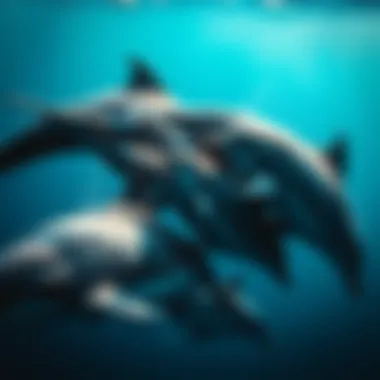
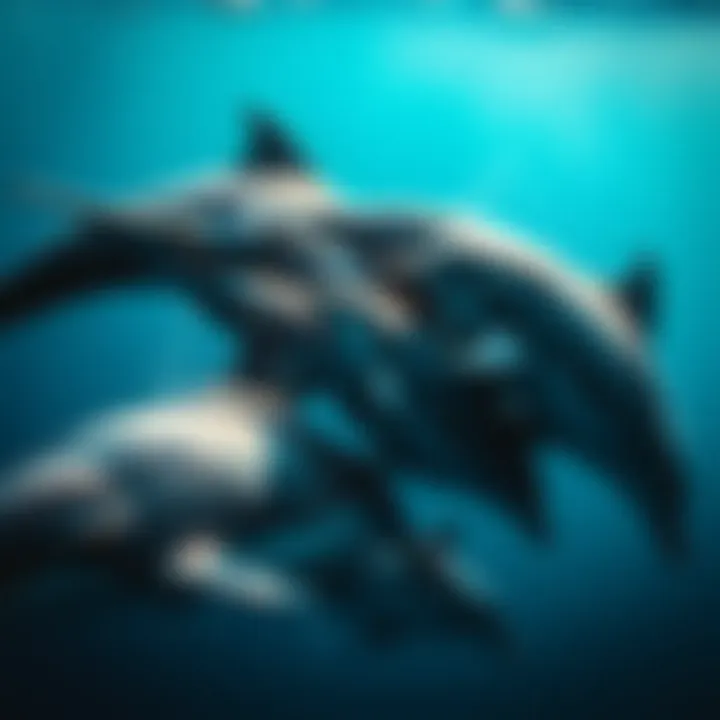
Understanding the intricate emotional and behavioral aspects of dolphin families illuminates the profound impact of familial ties on dolphin life and conservation efforts. The more we grasp their emotional worlds, the better we can advocate for their futures in the wild.
In sum, the study of dolphin emotionality and behavioral adaptations highlights how these creatures rely on familial structures to navigate their complex underwater environments. The interplay between empathy, altruism, and adapted behaviors paints a vibrant picture of their social systems, showcasing the necessity of preserving these bonds for the sustainability of dolphin populations.
Impact of Environmental Factors on Family Dynamics
Exploring the impact of environmental factors on dolphin family dynamics opens a window to understanding how these magnificent creatures endure through changing habitats. This segment highlights specific elements such as habitat changes and pollution, posing serious considerations about modern life in the ocean and its consequences for dolphin social structures. As we delve deeper, it's essential to acknowledge that changes in the environment can reverberate through dolphin families, affecting their very survival.
Habitat Changes and Family Disruption
Dolphins depend greatly on their habitats, which are often intricate ecosystems made up of coral reefs, estuaries, and coastal waters. These environments offer essential resources such as shelter, food, and breeding grounds. But it's not all smooth sailing. Rapid urban development, climate change, and natural disasters are altering these habitats at an alarming pace. For instance, the rise in sea temperatures can lead to coral bleaching, hence reducing biodiversity.
When habitat integrity is compromised, dolphin families must adapt quickly. Some may relocate to find better conditions, but this migration can disrupt familial bonds that have taken years to establish. For example, an extended family group that relies on a specific estuary for nurturing young may find their territory impaired, pushing mothers to make difficult decisions regarding their offspring's safety. Its a hard choice, whether to leave familiar waters to seek stability elsewhere or to stay put, risking the well-being of the young.
"Dolphins are known to exhibit a strong sense of place, and disruption to their habitat can fracture the social bonds that are vital for their survival."
Adaptations to these stresses often result in changes in social dynamics. Family groups may become smaller or more fragmented, impacting their roles in cooperative hunting and mutual care of the young. Social learning, which is crucial for transmitting skills and knowledge, may also be severely affected, jeopardizing the next generation's survival.
Pollution and Its Effects on Social Structures
The ominous shadow of pollution looms over marine life, and dolphins are no exception. Runoff from agriculture, industrial waste, and plastic debris introduce toxins into ocean waters. These hazards threaten not only the dolphins' physical health but also their social structures. High levels of contaminants in prey species can lead to health issues, impacting reproductive success and the ability to care for calves.
With dolphins being top predators, the accumulation of toxins leads to serious health ramifications that ripple through family units. Behavioral changes might arise, such as increased aggression or decreased social interactions among dolphins. Families that once thrived in unity may find themselves isolated or struggling to regain their former dynamics. Moreover, a ill dolphin can significantly impact the group's functionality, as the social structure relies on each member contributing.
Increasingly, studies point to pollution as a factor that drives changes in social grouping. A family might splinter apart as individuals seek cleaner environments, which in itself can lead to further genetics isolation and an inability to adapt to new challenges.
In summary, the environmental pressures that dolphins face are deeply interconnected with their family dynamics. Without an understanding of these relationships, conservation efforts may miss the mark, hindering the very essence of dolphin survival.
For further reading on environmental impacts on marine life, you might explore these sources: National Oceanic and Atmospheric Administration, World Wildlife Fund and Marine Conservation Society.
By recognizing and addressing these environmental challenges, we can not only help safeguard dolphin families but also protect the intricate web of life in the marine ecosystem.
Conservation Implications
Dolphins are not just fascinating creatures residing in the vast blue expanse of our oceans; their familial bonds and social structures are essential to understanding their survival and well-being. Conservation efforts targeting these marine mammals have begun to recognize the profound impact that family dynamics have on their overall population health. Families are the foundation of dolphin society, and understanding their structure plays a significant role in ensuring these species thrive in their natural habitats.
The Importance of Family in Conservation
When we look at conservation programs aimed at protecting dolphin populations, it becomes evident that the emotional and social aspects of these creatures cannot be overlooked. For instance, when dolphins are taken out of their family groups due to increased fishing or habitat destruction, it can lead to long-lasting emotional trauma, not just for the individual but for the entire family unit. Programs that focus on the preservation of family groups tend to have better success rates.
"Protecting dolphin family units is not just about conserving a species; it’s about preserving the intricate web of life within our oceans."
- Conservation Measures
- Preserving Habitats: Ensuring that their natural habitat is protected from pollution and overfishing enables dolphin families to thrive.
- Community Awareness: Educating local communities about the significance of dolphin familial bonds can lead to grassroots conservation initiatives.
- Family-Oriented Research: Continuing research into specific family dynamics can highlight unique vulnerabilities and strengths within dolphin populations.
Understanding Familial Importance in Conservation Programs
The understanding of familial importance extends far beyond the surface level of conservation. Programs tailored to these dynamics address the emotional and social needs of dolphin pods.
In many cases, conservation efforts that take into account how dolphins interact with one another have shown a more holistic approach. Close relationships within dolphin families can mean enhanced survival rates, particularly among calves who depend on their mothers for both protection and learning.
Moreover, tracking familial structures can offer insights into migration patterns, feeding habits, and overall health of dolphin populations. If researchers can tie family group dynamics to conservation initiatives, they can create more targeted and effective strategies.
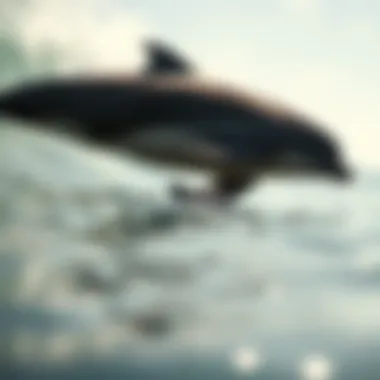
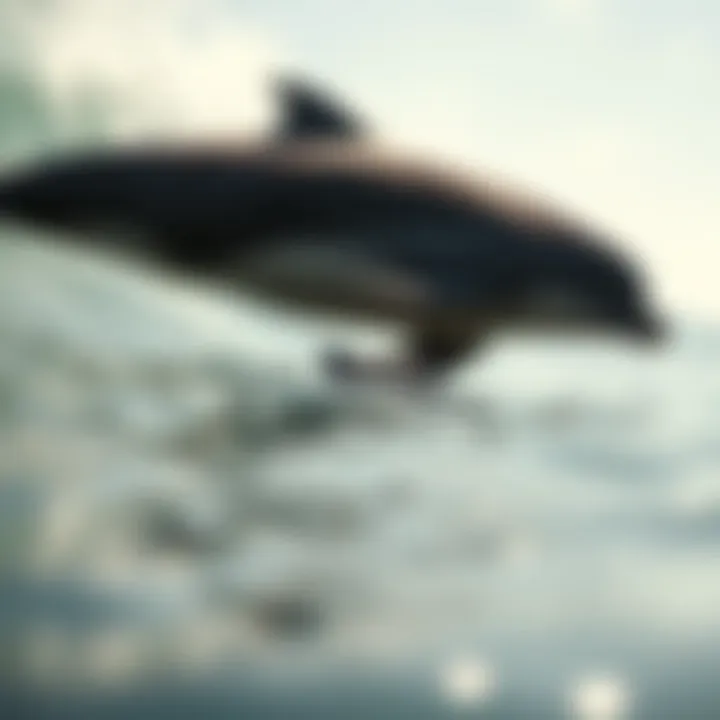
Role of Families in Dolphin Populations and Ecosystems
The role that families play in dolphin populations isn't just about social interaction; it’s about ecological balance. Dolphins are apex predators, and their family units contribute to the overall health of marine ecosystems. When dolphin families thrive, the entire ecosystem flourishes.
- Predatory Dynamics: Dolphin families work together to hunt, teaching younger members the skills needed for survival. This cooperation leads to a balanced marine food web.
- Ecosystem Engineers: As predators, dolphins help regulate fish populations. Healthy families ensure that these dynamics continue to support biodiversity.
- Cultural Spread: Knowledge about foraging techniques and migratory paths is often passed down through family units. Protecting these families promotes cultural continuity in dolphin behavior.
In summary, family bonds in dolphins are not merely social; they are critical to the health of the species and the wider marine environment. Efforts to conserve these remarkable animals must prioritize family structures, understanding that the significance of their bonds extends far beyond their immediate interactions.
For more information, you can explore resources such as National Oceanic and Atmospheric Administration (NOAA) or engage with local conservation groups dedicated to marine life wellness as found on platforms like Reddit or Facebook.
Case Studies of Dolphin Family Structures
Understanding the family structures of dolphins is as vital as deciphering ancient texts to a historian. These studies shed light not just on individual species but also contribute significantly to our overall comprehension of dolphin behavior, ecology, and conservation. By observing distinct family units and their unique dynamics, we can better appreciate how these complexities influence survival strategies and interaction patterns within marine ecosystems.
Case studies provide a detailed narrative, portraying the diversity and adaptability of dolphin family structures. They allow researchers to analyze patterns in social behavior, communication styles, and conflict resolution—elements that are often obscured in broader studies. Moreover, the findings can lead to informed conservation efforts tailored to protect the specific needs and environments of various dolphin species.
Bottlenose Dolphins: A Closer Look
Bottlenose dolphins stand out as some of the most studied and recognized dolphins in the world. Their social structures are described as fluid, flexible, and dynamic. Unlike other species, bottlenose pods can shift rapidly, merging and splitting based on environmental conditions and social interactions.
"Bottlenose dolphins exhibit a range of group sizes, from small family units consisting of a mother and her offspring to larger aggregations involving dozens of individuals."
Their nuclear families often comprise a mother and her calves, who tend to stay close, sharing foraging strategies and protective behaviors. Conversely, extended family relationships can form outside the immediate kin, with social bonds established through cooperative hunting or protective behaviors against predators.
Several key elements make the study of bottlenose family structures especially valuable:
- Foraging Techniques: Research has uncovered distinct hunting strategies employed by family members, showcasing how collective effort enhances success rates.
- Protective Dynamics: Bottlenose pods can exhibit remarkable protective behaviors. Notably, they often engage in vigilance to ward off threats, illustrating their acute social awareness.
- Vocal Communication: The communicative repertoire of bottlenose dolphins is rich and nuanced, which plays a role in maintaining cohesion within family groups.
Orca Family Dynamics
Orcas, or killer whales, are remarkable for their sophisticated family structures. They often form matrilineal groups—this means that familial bonds are typically centered around a matriarch, the oldest female in the group. These family units can last a lifetime, with offspring remaining with their mothers for years, sometimes even decades.
The social dynamics within orca pods involve complex hierarchies and cooperative interactions that enhance their survival. The following aspects of orca family dynamics offer crucial insights:
- Matrilineal Bonds: Mothers play a pivotal role in guiding their families, teaching foraging techniques, and social norms.
- Adaptive Hunting: Orca pods often display innovative hunting strategies, employing teamwork to capture prey such as seals or even larger whale species.
- Cultural Transmission: Unique behaviors within orca pods, such as specific hunting techniques or vocalizations, signify cultural learning that is passed from generation to generation.
Understanding these family structures is imperative for the conservation of these giant marine mammals. Protecting matrilineal groups ensures the survival of crucial knowledge and skills necessary for thriving in the challenging ocean environment.
In summary, the case studies of dolphin family structures underscore the importance of close-knit relationships in dolphin societies. By diving deep into the behaviors and family dynamics of bottlenose dolphins and orcas, we unlock keys to better conservation strategies and enhance our appreciation for these intelligent creatures.
Epilogue: The Significance of Family in Dolphin Life
In wrapping up our exploration of dolphins and their intricate family bonds, it becomes evident just how significant these ties are in shaping their social structure and behavior. Dolphins exhibit remarkable familial connections that not only guide daily interactions but also play a profound role in their overall survival.
Family serves as the backbone of dolphin societies, primarily influencing their communication patterns, emotional well-being, and survival strategies. When we look closer, we see that dolphins are not mere solitary beings; they thrive within complex networks of relationships that elevate the importance of working together and fostering lifelong ties. This symbiotic existence underpins much of their behavior and resilience.
Summary of Findings
The analysis throughout this article has shed light on various aspects of dolphin familial bonds, revealing several key findings:
- Social Structures: Dolphins typically form family units, which can be nuclear families or larger extended groups. Each unit serves unique roles in protecting and nurturing its members.
- Effective Communication: The vocalizations and non-verbal cues dolphins use reflect the depth of their social connections. These methods of interaction are essential for maintaining social bonds and ensuring group cohesion.
- Emotional Connections: Dolphins demonstrate empathy and altruism, traits that are often strongest among family members. Such behaviors enhance survival rates, especially in times of distress.
- Impact of Environment: External factors such as habitat changes or pollution directly affect family dynamics. Understanding these shifts is crucial for conservation initiatives aiming to support dolphin populations.
- Conservation Importance: Recognizing the familial importance of dolphins is vital for conservation programs, as protecting family units ensures the stability of entire populations.
"Dolphins remain closely bonded throughout life, and these enduring relationships are fundamental to their survival and well-being."
Future Research Directions
As our understanding of dolphin family dynamics continues to grow, several future research directions emerge:
- Longitudinal Studies: Monitoring specific dolphin families over extended periods can provide invaluable insights into how relationships evolve and influence behavior, especially as environmental conditions change.
- Genetic Links: Investigating genetic relationships within family units can clarify how familial ties manifest in social structures and whether these affect longevity and reproductive success.
- Impact of Human Activity: Further studies examining the impact of shipping, pollution, and tourism on dolphin family structures can inform better conservation efforts and protection policies.
- Cross-Species Comparisons: Exploring familial structures across different dolphin species could unearth varying adaptive strategies and highlight conservation needs unique to each species.
- Behavioral Studies in Natural Settings: Observations of dolphin interactions in their natural habitats can reveal how they navigate challenges as a family, providing a deeper understanding of their social dynamics.















